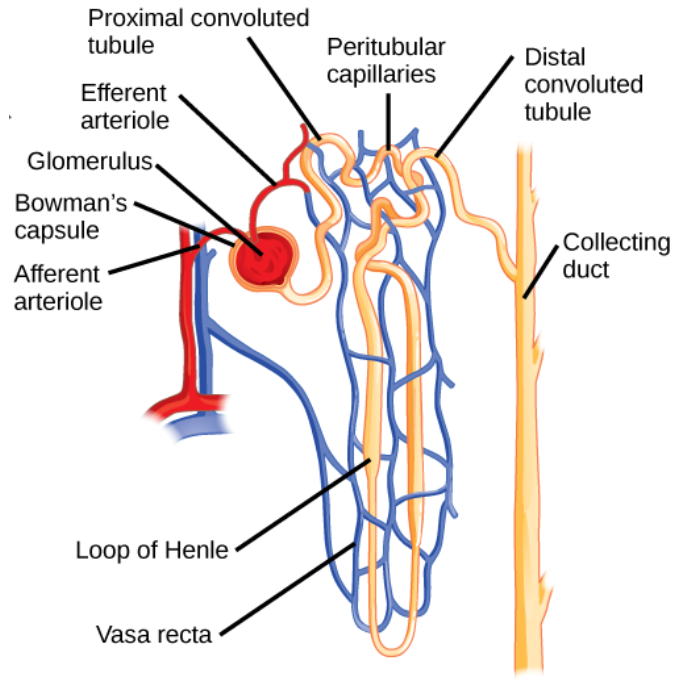
Explain the function of the vasa recta.
Answer
491.4k+ views
3 likes
Hint: Vasa recta are the capillary networks that supply blood to the medulla, that run parallel to the loops of Henle. They are highly permeable to solute and water.
Complete Answer:
Vasa recta are the series of long loops of thin-walled blood vessels (efferent arterioles) that dip down alongside the loop of Henle in the vertebrate kidney. These capillaries are hairpin-shaped blood vessels and they run parallel to the loops of Henle.

- This hairpin structure turns down the rate of blood flow, which helps in maintaining the osmotic gradient required for water reabsorption.
- Henle’s loop and vasa recta play a significant role in water reabsorption. The flow of filtrate in the two limbs of Henle’s loop is in opposite directions and thus forms a counter current. The flow of blood through the two limbs of the vasa recta is also in a countercurrent pattern.
- The proximity between the Henle’s loop and vasa recta, as well as the countercurrent in them, help in maintaining an increasing osmolarity towards the inner medullary interstitium, i.e., from 300 mOsmolL–1 in the cortex to about 1200 mOsmolL–1 in the inner medulla.
- This gradient is mainly caused by NaCl and urea. NaCl is transported by the ascending limb of Henle’s loop which is exchanged with the descending limb of the vasa recta. NaCl is returned to the interstitium by the ascending portion of the vasa recta.
- Similarly, small amounts of urea enter the thin segment of the ascending limb of Henle’s loop which is transported back to the interstitium by the collecting tubule.
- The above-described transport of substances facilitated by the special arrangement of Henle’s loop and vasa recta is called the countercurrent mechanism. This mechanism helps to maintain a concentration gradient
Note: It is to be noted that concentration gradient is established during the countercurrent mechanism. This counter-current mechanism is maintained by selective permeability in the loops of Henle and passive diffusion in the vasa recta.
Complete Answer:
Vasa recta are the series of long loops of thin-walled blood vessels (efferent arterioles) that dip down alongside the loop of Henle in the vertebrate kidney. These capillaries are hairpin-shaped blood vessels and they run parallel to the loops of Henle.

- This hairpin structure turns down the rate of blood flow, which helps in maintaining the osmotic gradient required for water reabsorption.
- Henle’s loop and vasa recta play a significant role in water reabsorption. The flow of filtrate in the two limbs of Henle’s loop is in opposite directions and thus forms a counter current. The flow of blood through the two limbs of the vasa recta is also in a countercurrent pattern.
- The proximity between the Henle’s loop and vasa recta, as well as the countercurrent in them, help in maintaining an increasing osmolarity towards the inner medullary interstitium, i.e., from 300 mOsmolL–1 in the cortex to about 1200 mOsmolL–1 in the inner medulla.
- This gradient is mainly caused by NaCl and urea. NaCl is transported by the ascending limb of Henle’s loop which is exchanged with the descending limb of the vasa recta. NaCl is returned to the interstitium by the ascending portion of the vasa recta.
- Similarly, small amounts of urea enter the thin segment of the ascending limb of Henle’s loop which is transported back to the interstitium by the collecting tubule.
- The above-described transport of substances facilitated by the special arrangement of Henle’s loop and vasa recta is called the countercurrent mechanism. This mechanism helps to maintain a concentration gradient
Note: It is to be noted that concentration gradient is established during the countercurrent mechanism. This counter-current mechanism is maintained by selective permeability in the loops of Henle and passive diffusion in the vasa recta.
Latest Vedantu courses for you
Grade 10 | CBSE | SCHOOL | English
Vedantu 10 CBSE Pro Course - (2025-26)
School Full course for CBSE students
₹37,300 per year
Recently Updated Pages
Master Class 10 Science: Engaging Questions & Answers for Success

Master Class 10 Social Science: Engaging Questions & Answers for Success

Master Class 10 Maths: Engaging Questions & Answers for Success

Master Class 10 English: Engaging Questions & Answers for Success

Class 10 Question and Answer - Your Ultimate Solutions Guide

Master Class 9 General Knowledge: Engaging Questions & Answers for Success

Trending doubts
A boat goes 24 km upstream and 28 km downstream in class 10 maths CBSE

Why is there a time difference of about 5 hours between class 10 social science CBSE

The British separated Burma Myanmar from India in 1935 class 10 social science CBSE

The Equation xxx + 2 is Satisfied when x is Equal to Class 10 Maths

Chandigarh is the capital of A Punjab B Haryana C Punjab class 10 social science CBSE

What are the public facilities provided by the government? Also explain each facility




